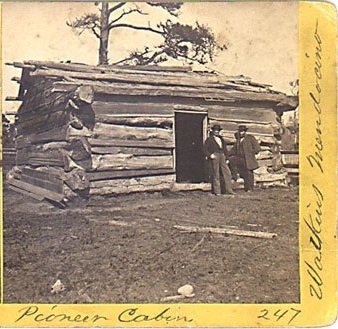
This 1863 Carleton Watkins photo shows David Lansing (left) and Jerome Ford (right) posing by the cabin they lived in when they first arrived in Mendocino. (Kelley House Museum Photograph)
Historians agree that what gold did for California, redwood timber did for the Mendocino Coast. A rough and tumble group of men and women came to California in search of gold and wealth. Many found it in the gold fields; many more did not. The same spirit motivated a group of pioneers to come to this coast. Captain David F. Lansing was one of the lucky ones who struck it rich here.
Lansing was born September 14, 1809 in Albany, New York, to parents David Lansing senior and Mercy Buckby. The original Lansings (also spelled Lansingh or Lansinck) came to New York from Holland around 1650. The records indicate that the early generations of Lansings were mostly landowners and lawyers, but like many New England youths, Lansing went to sea at an early age. His first long voyage was on board a whaler that spent three years in the South Pacific. The young Lansing proved to be an able seaman, and he became a captain in his early twenties, making many voyages around Cape Horn and meeting with moderate success as a whaler.
In 1849 Lansing, who had married Charlotte Whipple (also from Albany) in about 1840, gathered up his wife and two daughters (Mary, b. 1841 and Charlotte b. 1847) and sailed the barque “Hannah Sprague” from New York harbor via Cape Horn to the mouth of San Francisco Bay. They arrived on November 12, 1849. The entire voyage took 175 days to complete, consisting of 18,000 nautical miles. Not much else is known about Captain Lansing or his family during the years 1849-1852 other than that Charlotte gave birth to their third daughter, Francesca “Fanny” Lansing, while at sea in October 1849.
In 1852 Lansing became Captain of the brig “Ontario,” a ship of 557 tons built in New York in 1812. The ship was under charter to E. C. Williams, William H. Kelley, and J. E. Carlson and was to carry the machinery owned by Henry Meiggs for the building of a sawmill at Big River. Meiggs employed Lansing to pilot the ship to Mendocino Bay and then remain on as supervisor of shipping at the new undertaking. E. C. Williams was on board the ship during the voyage to Mendocino and in 1912 he penned the following account of the journey:
“(We) set sail early in June, 1852. We were not yet out of sight of land when trouble began. The ship which had been at anchor for a very long time had become dry at the waterline and as soon as it was put into the wind and headed up the coast the motion began to loosen the oakum in the seams and let water in, not much at first but (it) increased daily. The workmen became alarmed and wanted to turn around but Captain Lansing stated that with good weather no danger existed, the workmen agreed that if they were put on pay they would man the pumps and keep the ship free (of water). It worked and we made it to port without mishap. After the men hauled the ship inside the point with the stern close to the shore, they landed her cargo. Later the hold was filled with rock from the bank until the hull was fast on the bottom—our intention being to complete the filling of the hold and thus make a permanent wharf and breakwater. This, however, was deferred too long and the first storm separated the upper works from the heavily weighted portion and washed it up on the beach.” (from the Mendocino Beacon, 1912).
After Henry Meiggs left the country in 1854, five men—Alfred Godeffroy, William Sillem, John Freundt, J.B. Ford, and E.C. Williams—reopened the mill in 1855 and retained Lansing as harbor master and shipping superintendent until 1874. In his book “The Doghole Schooners” [Mendocino Historical Research, 1977], Walter Jackson noted that Lansing as harbor master spent many days in a rowboat locating dangerous underwater rocks and reefs in Mendocino Bay and marking them as hazards to navigation. Lansing often remarked that he had witnessed the deaths by drowning of at least 50 persons in the bay as the result of shipwrecks, capsizing rowboats, falls from cliffs, or from being washed off the rocks while fishing.
To be continued
— Excerpted and annotated from the Mendocino Historical Review, Spring, 1985.
The Kelley House Museum is open from 11AM to 3PM Thursday through Monday. Walking Tours of Mendocino are available throughout the week. Visit the Kelley House Event Calendar for a Walking Tour schedule.